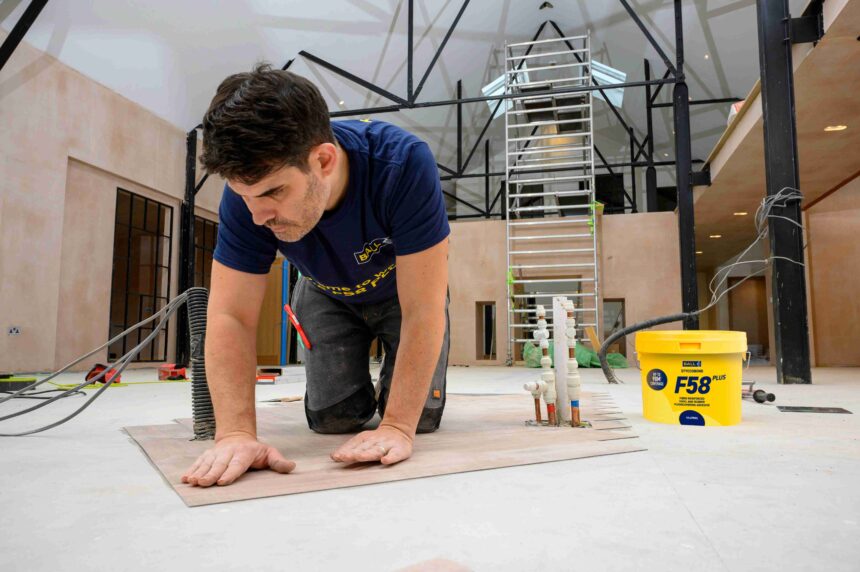The Knowledge: Optimising LVT Installations

In this series, we tell you what you need to know to ensure flooring installations live up to high customer expectations.
Previously, The Knowledge has dealt with subfloor preparation, including identifying and dealing with excess subfloor moisture, as well as the application of a smoothing compound to ensure a perfectly smooth base for floorcoverings. We’ve also looked at selecting an appropriate adhesive for a floorcovering installation, including checking the compatibility of the adhesive with the chosen floorcoverings.
This time, we are bringing these things together to advise on ensuring optimum results when installing a particular type of floorcovering: increasingly popular Luxury Vinyl Tiles (LVTs). Given the premium associated with LVTs and customers’ high expectations for finished results, it is important to ensure a flawless finish when installing them. A long-lasting, visually attractive flooring finish when installing luxury vinyl tiles or planks involves following the same principles of subfloor preparation and adhesive selection, with certain products helping with both the installation process and optimising the appearance and longevity of the finished results.
Creating a base
F. Ball recommends that a smoothing compound is applied over the subfloor to create a perfectly smooth base for the receipt of floorcoverings and ensure that the visual appearance of an installation is not compromised by imperfections in the subfloor showing through.
Before you apply a smoothing compound, the first step in any flooring installation should be to check that the subfloor is suitably sound, smooth and dry. Any laitance and contaminants should be mechanically removed.
At this stage, a moisture test should be conducted to determine if the subfloor is dry enough to receive floorcoverings. Where Relative Humidity (RH) levels are higher than 75%, a moisture management solution will be required to prevent moisture attacking flooring adhesives and causing resilient floor coverings to blister and lift, potentially ruining the appearance of the installation. The usual solution for suppressing excess subfloor moisture is the application of a liquid waterproof surface membrane.
Prime importance
As discussed previously, in most cases you also need to prime the subfloor before the application of a smoothing compound. Primers promote adhesion of the smoothing compound to the subfloor. Applied over absorbent subfloors, they also stop the unacceptably rapid drying of smoothing compounds, which can result in insufficient strength build up and a reduction in the open time or wet edge of the smoothing compound.
Another benefit of priming is reducing ‘pinholing’: small holes in the smoothing compound that have the appearance of pinholes or blisters caused by the slow escape of air from absorbent surfaces as the smoothing compound cures.
Adhesive selection
To adhere the LVTs to the smoothing compound, pressure sensitive adhesives, such as F. Ball’s Styccobond F46, are usually the best choice. They form an instant grab upon contact, so installers don’t need to worry about tiles or planks sliding about when they are working, making them ideal for installations with intricate designs or patterns.
Styccobond F46 is part of F. Ball’s ‘System LVT’ range, which comprises waterproof surface membranes, primers, smoothing compounds and adhesives that used correctly and in combination F. Ball guarantees will result in an aesthetically pleasing floor finish that lasts the lifetime of the installation.
The range also features pressure sensitive adhesives with a variety of other specialist attributes, including moisture tolerance and the ability to hold vinyl floorcoverings firmly in place in areas exposed to extreme temperature fluctuations (from -20°C to +60°C).
Compatibility check
As we said in the previous installment of The Knowledge, it is always advisable to check the compatibility of particular floorcoverings and adhesives to prevent the possibility of floor failure. To do this, you can consult the floor covering manufacturer’s guidelines. Alternatively, F. Ball produces a Recommended Adhesives Guide (RAG®), which lists adhesives recommended for use with over 6,000 floorcoverings produced by over 200 manufacturers. The guide is available as a free app or a printed booklet. An interactive version can also be found on the F. Ball website. Alternatively, contractors can contact F. Ball’s technical service department, from 8.30am–5.00pm, Monday to Friday, for advice on adhesive compatibility, as well as subfloor preparation and floor covering installation. They can also arrange site visits to identify and advise on the best course of action for any flooring project.
Free training
Free training courses on achieving optimum results when installing LVTs are also hosted at the F. Ball Centre of Excellence at F. Ball’s Staffordshire headquarters. You can find details of upcoming courses here, as well as on the F. Ball website, where you can also book a place for yourself or colleagues.